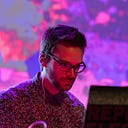Drawing with wheelchairs at the Southbank
We ran a workshop at the Southbank Centre, London exploring different forms of drawing using the motion of wheelchairs. Starting with physical drawing and moving to digital drawing as forms of activisim.
The goal of the workshop was to use tools to find new ways of seeing and exploring spaces, creating work that expressed the feelings of existing in that space.
Physical drawing
The company Enayball (https://www.enayball.com/) was kind enough to let us use their latest prototype for drawing through wheelchair motion. A small attachment with a pen slot (with downward force) that can be attached using a universal clamp. We drew on paper attached in large strips with masking tape to the floor.
We tried various attachment locations on the chair and for mediums Charcoal and Pecco pens (ink chalk). Charcoal drew strong, high contrast lines but was a little too fragile with quite a few breakages. Participants were not directed in what they drew, but encourage to explore. Most explored their feelings of navigating the building and especially trying to find their way inside.
Here on the left the participant Nick expressed the cobbles on entering the building.
The large circular swirls and smaller swirls expressed his feelings of going around in circles trying to find the right way into the building.
Abdur-Raheem explored the precision he could achieve through his joystick controlled chair.
Augmented Reality drawing
We asked participants to express how the space made them feel. They choose the words “Small and insignificant, looming, dizzying.”
We used this phrase to create Augmented Reality ribbons attaching or holding an Iphone or Ipad and moving through the space.
Alternative image text: Two photos with augmented reality drawings. The first shows a black ribbon with white text creating swirling patterns with some broken/missing parts in the line. The second picture shows text that is made up from background pictures of the same space. A little like a collage with letters cut out of photos.
Alternative video description: A wooden floor ballroom with white pillars. There is a digital black ribbon flowing through the space near the floor. The ribbon has white text saying: “Small and insignificant, looming, dizzying” repeated. As the camera follows the trail which stretches out over the ballroom with curves and loops we see the creator Abdur-Raheem sitting in a powered wheelchair. The augmented reality ribbon flows around him and past his shoulder.
Motion and intention drawing
A GoPro camera was attached to the front left fork of a manual wheelchair. This captures a different perspective to the eyes of the participant, not just in terms of height but in direction. Capturing intention through earlier wheel turns that happen before a new direction or movement is achieved.
Participants imagined a drawing which was captured through video footage of their motion. This was the first time a participant used backwards motion as part of the drawing process (marked as dotted turquoise lines).
Alternative video description: A low ground view of the Clore ballroom from the perspective of a camera attached close to the front coaster wheel. The person first explores the entire space, especially around the pillars. Then they start exploring lots of smaller circular patterns. Finally the person plays with forward and backward motion intermixed.
Indoor positioning
We had some software issues with our indoor tracking system, so instead we focused on looking at the hardware and discussing the Ultrawide band technology they use. It was nice to be able to see inside the sensors with open circuits and explore weight and positioning issues on powered and manual wheelchairs.
Conclusions/Thoughts
The participants used the digital tools to explore the space guided by creativity rather than a functional view. Visting hidden corners or exploring the boundries and elements of the space. The architecture of the pillars played an important part becoming a focus of interactive, playful motion. There is something joyful in circling pillars with wheels that might be a connection with dance. Viewing the drawing as a performance reinforces this idea.
The participants carried their experiences of barriers communting to the venue into the workshop. Finding busses, parking, bad surfaces and finding the right entrance. While we were exploring a specific space, the experience and barriers of travel in London are impossible to ignore as influences and as barriers to participate. When there is a tension with the build environment and its expectations on your body, using creativity to explore a space, with you in control and creating an expression of your experience is powerful.
The use of backwards motion to draw was interesting as some forms of tracking would miss this. It also reflects an important part of my vision of the relationship with technology and disability, taking ownership through mis-use or novel use.
As always there is a common thread with participants about the experience of barriers. Unsurprising if we define disability as the barriers created by society. The experience acts as a connection and sharing it brings the group together. Advocacy and creative disruption naturally emerge.
Support
Commissioned and supported by Unlimited, celebrating the work of disabled artists, with funding from SouthBank Centre and Arts Council England.
Workshop space was provided by The Southbank Centre, London, UK.
Thanks to all workshop participants for their engagement and creativity.
